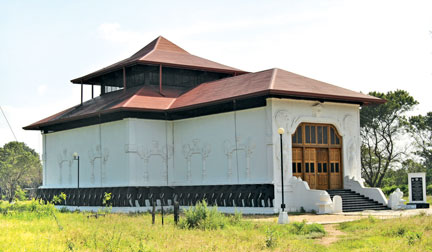|
Deegavapi Vihara:
Sacred shrine blessed by the Buddha

|

The newly built shrine |
Driving away from the bustling city of Ampara, towards East on
Akkaraipattu Road for almost 18 km, brings you to the point where you
are required to make a left turn from the main road to enter Deegavapi
Temple Road. This path, has a dead end at the garden of the shrine, and
passes a small hamlet of Muslim community and a picturesque ambience.
Once you pass the locale, it is just the plain lush green valley, which
allows you a splendid panorama up to the sky.
By the time we arrived at the temple, it was almost deserted and
there was hardly anybody to be seen except one or two vendors. The
mesmerizing serenity of the temple resembled the idyllic setting of a
place blessed by the Buddha. It was during the third visit the Blessed
One visited Deegavapi shrine with 500 other arahants and had spent the
time meditating. Of course, although occasionally a peacock breaches the
silence of the atmosphere, it is the perfect place to meditate.
After parking the vehicle at the gate of Deegavapi Vihara, we hurried
passing the two storeyed monks' abode until the Stupa was in our
vicinity. Did I expect to see a beautiful dazzling white Stupa like
Ruwamweliseya? Maybe, I did not. Deegavapi is nothing like a Stupa. It
rather gives an impression of a heap of bricks and plants. The
circumference of the Stupa is 1000 feet, and it has been restored only
up to 30 feet of the height. Rest of the height is a small jungle with
various bushes on it. According to archaeologists, the Stupa was 110
feet high in 1964. However, a report by Badigode Buddharakitha thera
says that the height of the Stupa was 185 feet in 1845. I presumed that
on top of the Stupa there was an eagle's nest as well. Flower pedestals,
foot prints of the Buddha, and ruins of a beautifully decorated
Vahalkada were seen all over the place. There are ruins scattered around
the premises.
The Stupa had been built by King Saddhathissa (137 -119 BC), and is
considered as a 'Pariboghika Stupa', one which does not contain relics.
Being one of the 16 places blessed by the Buddha the shrine has become a
sacred place. The great chronicle Mahavamsa, states that the King had
also donated a jacket decorated with gold lotus flowers, and gems to
cover the Stupa. According to an inscription on a gold foil found during
an excavation, the Stupa was later renovated by king Kawanthissa who
ruled from 164 - 192BC.
The British took over the entire land that belonged to the temple. In
1886, the Governor had instructed the villagers to dig the area and
remove the bricks and granite slabs to be used for irrigation projects.
Buddhists had refused to take part in the excavation.
The project had ended leaving only a pile of soil at the area where
the Stupa was situated. Ven. Kohukumubure Revatha Thera, had located the
Stupa.
Later he started reconstructing the stupa. The thera also managed to
reclaim 250 acres of land back to the temple.

The Monks’ abode |

Deegavapi Stupa |

Ruins of a decorated Vahalkada |

Foot imprint of the Buddha Pedestal |

Stone flower pedestal |
Pix: Janani
Amarasekara |
|

